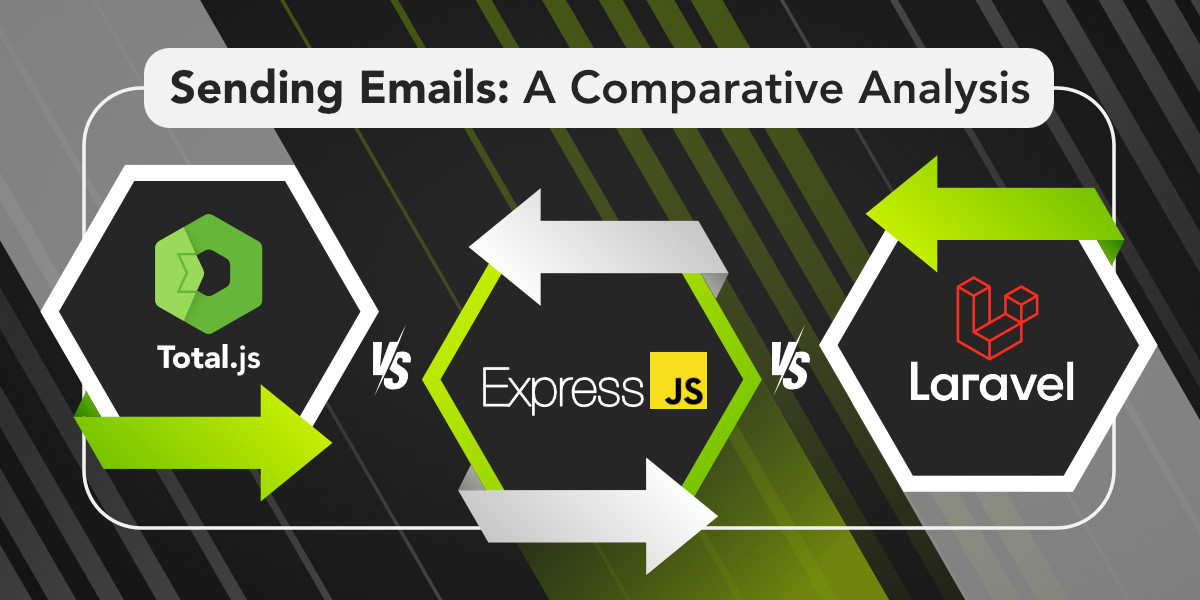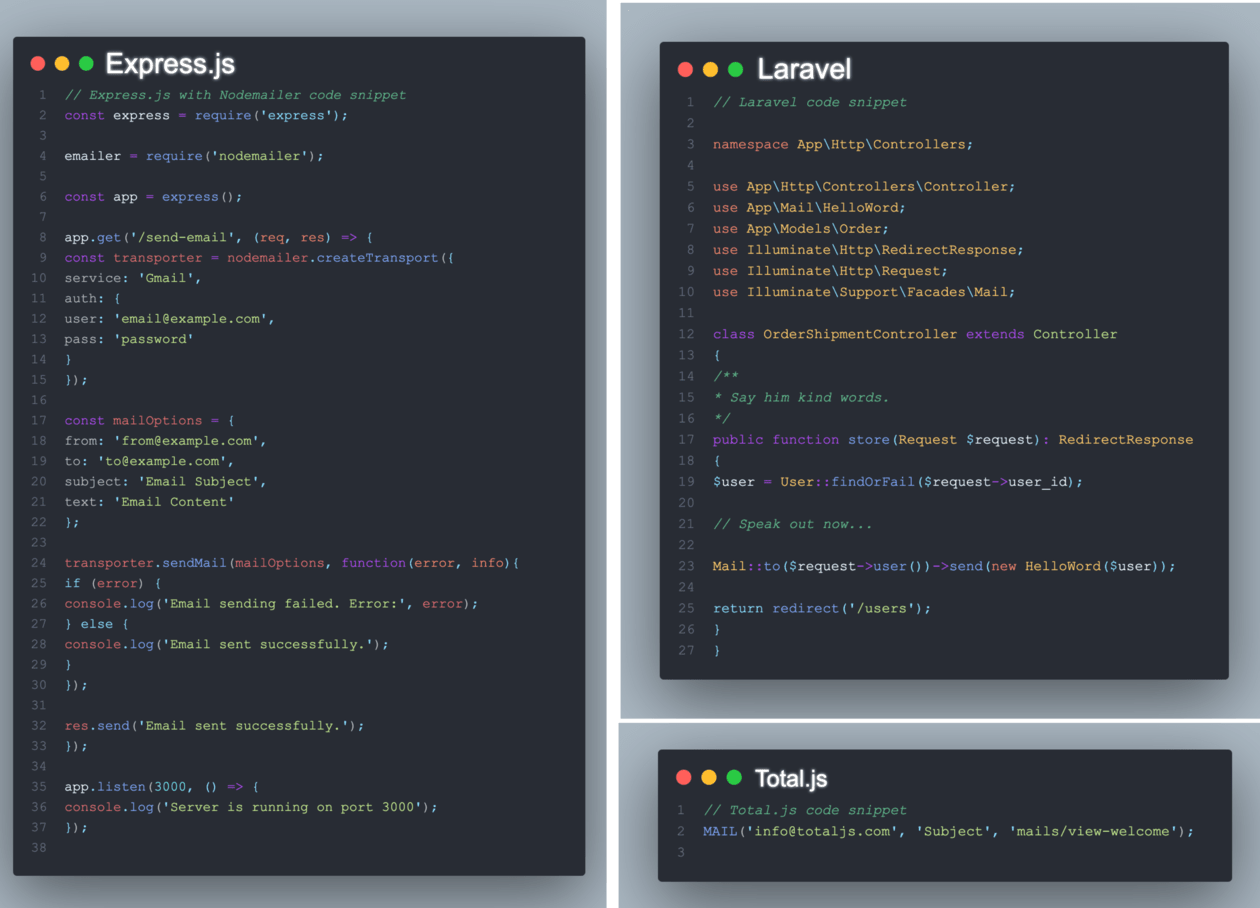In this blog post, we will compare the process of sending emails in Total.js, Express.js, and Laravel, highlighting their respective advantages. We'll also delve into why Total.js is a powerful choice for email sending, considering its robust features and benefits. By the end, you'll have a clear understanding of which framework or language is best suited for your email-sending needs.

Sending Emails: A Comparative Analysis of Total.js, Express.js, and Laravel
Sending emails is a critical functionality in web applications, and choosing the right framework can greatly impact the efficiency and convenience of this process. In this blog post, we will compare the process of sending emails in Total.js, Express.js, and Laravel, highlighting their respective advantages and disadvantages. We'll also delve into why Total.js is a powerful choice for email sending, considering its robust features and benefits. By the end, you'll have a clear understanding of which framework or language is best suited for your email-sending needs.
Overview

Disclaimer:
This blog post provides a general overview of the frameworks and their characteristics, but it is important to conduct thorough research and analysis before making any decisions regarding the selection of a framework for your specific project. The opinions expressed in this blog post are those of the author and should not be considered as professional advice or the sole basis for making decisions.
Sending Emails in Laravel
Laravel provides a comprehensive and straightforward way to send emails using its built-in Mail class. Laravel and Symfony Mailer provide drivers for sending email via SMTP, Mailgun, Postmark, Amazon SES, and Sendmail, allowing you to quickly get started sending mail through a local or cloud-based service of your choice.
Configuration
1. Application configuration
Laravel's email services may be configured via your application's config/mail.php configuration file. Each mailer configured within this file may have its own unique configuration and even its own unique transport.
2. Mailaible Generation
When building Laravel applications, each type of email sent by your application is represented as a mailable class. These classes are stored in the app/Mail directory.
3. Writing Mailables
Once you have generated a mailable class, open it up so we can explore its contents. Mailable class configuration is done in several methods, including the envelope, content, and attachment methods.
4. Configuring The Sender
First, configure the sender of the email. Or, in other words, who the email is going to be "from".
5. Configuring The View
Within a mailable class's content method, you may define the view, or which template should be used when rendering the email's contents.
6. Sending the mail
Here's an example of sending an email using Laravel:
Advantages of Laravel for Email Sending:
- Wide community support and extensive documentation
- Availability of third-party libraries like PHPMailer
- Flexibility in email configuration
Cons of Laravel for Email Sending:
- Requires a PHP environment and setup
- May have a learning curve for beginners
Sending Emails in Express.js
Express.js is a popular web framework for Node.js that can be used to handle email sending in a web application. While Express.js itself does not have built-in email-sending capabilities, it can be integrated with third-party libraries like Nodemailer for sending emails. Here's an example showcasing how to send an email using Express.js and Nodemailer:
Advantages of Express.js for Email Sending:
- Highly flexible and scalable web framework
- Integration with third-party libraries like Nodemailer for email sending
- Ability to handle complex routing and request handling
Cons of Express.js for Email Sending:
- Requires integration with third-party libraries for email sending
- May require additional configuration and setup
Sending Emails in Total.js
Total.js simplifies the process of sending emails through its built-in MAIL(for sending HTML messages generated from View Engine) and LOGMAIL(for sending plain-text messages) helpers. To configure Total.js for email sending, you can set the necessary parameters in a config file located at the root of your project. Here's an example of how you can configure the email settings:
Configuration
1. Global configuration
Create a config file at the root of your project and append the following configuration (twist them to fit your credentials)
2. Showcasing how to send an email using Total.js :
Advantages of Total.js for Email Sending:
- Simplified email sending through the built-in
MailHelper - Native template support for dynamic and visually appealing emails
- Asynchronous sending for improved application responsiveness
- Robust error handling and logging capabilities
- Seamless integration with the Total.js ecosystem
Cons of Total.js for Email Sending:
- Requires familiarity with the Total.js framework and JavaScript
Why Use Total.js for Email Sending?
When it comes to sending emails, Total.js offers a powerful solution with its Mail and LOGMAIL helpers. It simplifies the process, provides native template support, and offers asynchronous sending and robust error-handling capabilities. While Express.js and Laravel also have their merits and can be integrated with third-party libraries like Nodemailer and PHPMailer, Total.js stands out as a comprehensive framework with a focus on efficient and convenient email sending.
Stay tuned for more blog posts exploring the features and capabilities of Total.js, Express.js, Laravel, and other web development technologies to help you make informed decisions and enhance your development experience.
Other posts from Total.js Platform
- 2025-07-15NEWRevolutionize Your IoT Management with Total.js IoT Platform: Simplify, Monitor, and Optimize
- 2025-07-01June report 2025
- 2025-06-02May report 2025
- 2025-05-01April report 2025
- 2025-04-24j-Box - Total.js UI component
- 2025-04-14Beekeeping - recording damage caused by a brown bear
- 2025-04-11j-Importer - Total.js
- 2025-04-10The Thurzo House Museum
- 2025-04-02March report 2025
- 2025-03-28j-DataGrid - Total.js UI component part 2

